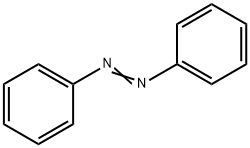Azobenzene , 1000μg/ml,inPurgeandTrapMethanol , 103-33-3
Synonym(s):
Diazobenzene, Diphenyl diimide, Diphenyldiazene;trans-Azobenzene
CAS NO.:103-33-3
Empirical Formula: C12H10N2
Molecular Weight: 182.22
MDL number: MFCD00003022
EINECS: 203-102-5
| Pack Size | Price | Stock | Quantity |
| 1ML | RMB215.20 | In Stock |
|
| others | Enquire |
PRODUCT Properties
| Melting point: | 65-68 °C (lit.) |
| Boiling point: | 293 °C (lit.) |
| Density | 1.09 g/mL at 25 °C (lit.) |
| vapor pressure | 1 mm Hg ( 104 °C) |
| refractive index | 1.62662 (78.1℃) |
| Flash point: | 100 °C |
| storage temp. | room temp |
| solubility | 6.4mg/l |
| form | Crystalline Powder |
| color | Orange |
| Water Solubility | Soluble in alcohol, ether, benzene and glacial acetic acid. Insoluble in water. |
| Merck | 14,917 |
| BRN | 1819138 |
| Stability: | Stable. Combustible. Incompatible with strong oxidizing agents. Air and light sensitive. |
| CAS DataBase Reference | 103-33-3(CAS DataBase Reference) |
| IARC | 3 (Vol. 8, Sup 7) 1987 |
| EPA Substance Registry System | Azobenzene (103-33-3) |
Description and Uses
Azobenzene is a well-known derivative of stimulus-responsive molecular switches and has shown superior performance as a functional material in biomedical applications.
Azobenzene is a typical photo-responsive molecule that isomerizes from its planar trans-form to the non-planar cis-form after UV-light irradiation with a wavelength between 300 nm and 400 nm (lmax is around 330 nm). Interestingly, the system reverts from the cis-form to the trans-form after further irradiation with visible light (wavelength over 400 nm). This process is completely reversible, and the azobenzene group does not decompose or induce undesirable side reactions even on repeated trans-cis isomerization. By introducing azobenzenes into DNA through D-threoninol as a linker, Asanuma and co-workers succeeded in achieving photo-regulation of:
Formation and dissociation of a DNA duplex
Transcription by T7-RNA polymerase reaction
Impurity in the production of Phenylbutazone (P319570).
Safety
| Symbol(GHS) |    GHS07,GHS08,GHS09 |
| Signal word | Danger |
| Hazard statements | H302+H332-H341-H350-H373-H410 |
| Precautionary statements | P202-P260-P273-P301+P312-P304+P340+P312-P308+P313 |
| Hazard Codes | T,N,Xn,F |
| Risk Statements | 45-20/22-48/22-50/53-68-67-65-62-51/53-38-11-48/20-39/23/24/25-23/24/25-52/53 |
| Safety Statements | 53-45-60-61-62-36/37-33-29-16-9-7 |
| RIDADR | UN 3077 9/PG 3 |
| WGK Germany | 3 |
| RTECS | CN1400000 |
| Autoignition Temperature | 890 °F |
| TSCA | Yes |
| HazardClass | 6.1(b) |
| PackingGroup | III |
| HS Code | 29270000 |
| Hazardous Substances Data | 103-33-3(Hazardous Substances Data) |
| Toxicity | LD50 orally in Rabbit: 1000 mg/kg |




